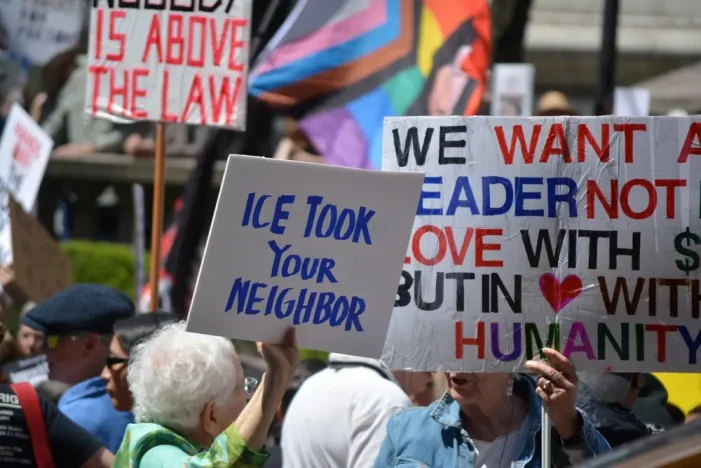By Brian Figeroux, Esq., the Law Firm of Figeroux & Associates | Editorial credit: Christopher Penler / Shutterstock.com
In today’s charged immigration enforcement climate, the risk of encountering U.S. Immigration and Customs Enforcement (ICE) is not limited to border zones. Across the United States—especially in urban centers—ICE officers have been observed approaching individuals in parks, on sidewalks, near schools, and even on public transportation. While many assume these encounters target adults, minors—particularly Black and Latino youth—have increasingly been subject to questioning or surveillance. For immigrant parents and guardians, this raises a critical question: What should your child know and do if ICE stops them and you are not present?
This article aims to guide parents through preparing their children—especially minors—for unexpected interactions with immigration enforcement. It addresses what documentation they should carry, what their rights are, what actions to avoid, what to do if they are wrongfully taken, and why this enforcement disproportionately impacts children of color.
- Understanding the Risk: Why Children of Color Are Targeted
While ICE purports to operate without racial bias, patterns of enforcement tell a different story. Black and Latino communities have historically borne the brunt of over-policing, surveillance, and discriminatory immigration enforcement. Many Afro-Caribbean and Afro-Latino immigrants are perceived as African American by law enforcement and therefore disproportionately stopped. Meanwhile, undocumented individuals from Canada, Ireland, Eastern Europe, and other predominantly white countries often benefit from the presumption of legality or simply go unnoticed due to racial bias in identification.
ICE’s internal guidelines officially restrict enforcement actions in sensitive locations such as schools and churches, but these guidelines are discretionary, not legally binding. The Trump administration explicitly loosened these restrictions, and while the Biden administration restored some protections, enforcement has not entirely ceased in or near public schools, transit hubs, and playgrounds.
- What to Teach Your Child to Do When ICE Approaches
When a child is approached by ICE—or any law enforcement officer—they must know their rights and how to safely assert them. The stakes are high. A misstep can lead to unlawful detention, deportation proceedings, or even family separation. Below are essential steps to teach your child.
- Remain Calm and Silent
Minors have the same constitutional protections as adults. They have the right to remain silent. Teach your child never to answer questions about:
- Their immigration status
- Where they were born
- Their parents’ immigration status
- Their address (if not comfortable disclosing)
A simple response such as, “I choose to remain silent. I want to speak to a lawyer,” is sufficient and protected by law.
- Do Not Consent to a Search
ICE may ask to look inside a backpack or on a phone. Without a warrant signed by a judge, your child is under no obligation to comply. Children should be instructed to say: “I do not give permission to search.”
- Ask for Legal Counsel
Minors should be taught to request a lawyer immediately and not to sign anything ICE puts in front of them, particularly documents in English they may not understand. Signing such documents can amount to waiving their rights or agreeing to removal proceedings.
- Never Run or Resist
Running from law enforcement can lead to physical harm or serious legal consequences. Instead, instruct your child to stay still, state their rights clearly, and refuse to engage in any conversation or physical contact unless accompanied by legal counsel.
- Memorize Emergency Contacts
Your child should know at least two phone numbers by heart: yours and another trusted adult who can act as an emergency contact. Consider writing these on a card they carry at all times.
III. Should Your Child Carry Identification?
Minors are not legally required to carry identification unless operating a vehicle. However, in the current enforcement climate, it may be prudent for immigrant children to carry the following:
- A school ID
- A note from parents or guardians that identifies the child and gives permission to contact a specific adult in case of emergency
- If undocumented, do not carry foreign documents (such as consular IDs or foreign birth certificates), as ICE may use these to initiate removal proceedings
For children who are U.S. citizens or have lawful status, a copy of their passport, birth certificate, or legal residency document can be helpful but should be carried only if necessary and with safeguards (e.g., in a sealed envelope labeled “Confidential: Legal Documents – Access Only by Guardian”).
- What if ICE Unlawfully Detains Your Child?
If ICE detains your minor child without lawful basis or you are unable to locate them:
- Call the ICE Detention Reporting and Information Line at 1-888-351-4024.
- Contact a trusted immigration attorney immediately to file a motion to produce or habeas corpus petition if the child is being held without proper cause.
- Document everything: Names, badge numbers, dates, and times of interaction.
- File a complaint with the Office of Civil Rights and Civil Liberties at DHS and, if necessary, consider a civil rights lawsuit against ICE.
ICE cannot detain children without cause or keep them separated from their guardians indefinitely. Any failure to provide access to legal counsel or guardian contact is a constitutional violation under the Due Process Clause.
- How to Prepare Your Family Legally and Emotionally
- Family Preparedness Plan
Create a “Family Immigration Safety Plan” which includes:
- Copies of all legal documents and IDs
- A notarized letter giving temporary custody to a trusted friend or relative
- Emergency instructions and caregiver consent forms for minors
- Enroll in a “Know Your Rights” Workshop
Many nonprofits, such as the ACLU, United We Dream, and Make the Road NY, host regular trainings for immigrant families. These workshops often provide physical “Red Cards” that help children invoke their rights when confronted by ICE.
- School-Based Protocols
Talk to your child’s school. Ask what the school’s protocol is if ICE arrives. Under FERPA (Family Educational Rights and Privacy Act), schools are prohibited from releasing student information without parental consent unless presented with a lawful subpoena.
- Why Undocumented Whites Aren’t Targeted the Same Way
Despite the presence of hundreds of thousands of undocumented white immigrants—particularly from Europe and Canada—ICE’s public operations overwhelmingly focus on Black and Latino populations. This stems from a combination of:
- Racial profiling and assumptions about immigration status
- Lack of language barriers or distinct accents among white immigrants
- Discretionary resource allocation that prioritizes visibility over legality
This is not merely anecdotal. A 2019 study by the Center for Migration Studies found that Irish and Canadian overstayers make up a substantial share of the undocumented population, yet are underrepresented in enforcement statistics. Meanwhile, the racialized policing of immigrant communities has been well-documented, including by the Migration Policy Institute and Human Rights Watch.
VII. Conclusion: Protecting Our Children in the Face of Fear
As a parent, your instinct is to protect your child at all costs. But in a system that disproportionately targets communities of color and criminalizes migration, your best protection lies in preparation, education, and collective advocacy. Teach your child their rights, ensure they have emergency plans, and hold institutions accountable.
No child should fear walking home from school or playing in the park. And no parent should fear never seeing them again because of a racialized, broken immigration system. Until systemic change arrives, proactive defense and community solidarity are your strongest shield.
Resources for Parents that are free and online:
- National Immigration Law Center: www.nilc.org
- Immigrant Legal Resource Center: www.ilrc.org
- ACLU Know Your Rights Cards: www.aclu.org/kyr-card
- ICE Detainee Locator: locator.ice.gov
- The Law firm of Figeroux & Associates, www.askthelawyer.us Call 855-768-8845.
Let your child’s first defense be their knowledge—not their vulnerability.

